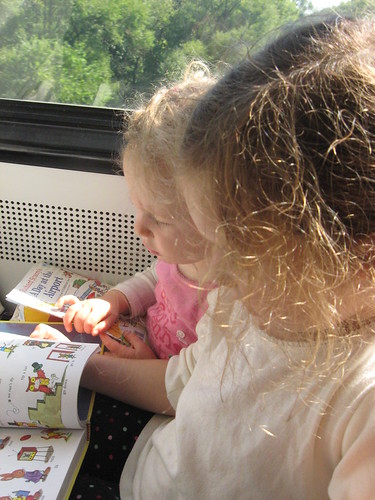Knitting is not the only craft that can be taught to young children. I’ve taught young children to crochet , and I’d thought, in another part of the Tips to Teach series, I’d tell you a bit about it. Some of these will be repeats, because I think it bears repeating, but some will be a bit different too.
Start with Double Crochet. Double crochet has more of a rhythm, I think, than single crochet, so I think it’s easier to teach. The way I talk about double crochet is, “Yarn over, go through the stitch, yarn over, pull through (3 loops on needle left), yarn over, pull through two (loops), yarn over, pull through two (loops).” If you notice, between each step is a yarn over, so it’s easier for children to know which step is next.
Have them start working into a swatch you’ve done. One of the most common problems I see when students start is that they make really tight stitches, and it’s hard to insert the hook into the stitches when you go to make the next row. To forestall this, I make a small sample for my students to work into. This way they can learn to identify stitches and also see how loose the stitches should be. And if they are too tight at first? I flip the swatch over and have them try again on the other side.
Show them both the pencil hold and the knife hold. This is a big one. I’ve found that teaching both handholds can often really turn the lightbulb on for a student. Sometimes, one just feels better than the other, and sometimes the switch to something that feels more natural for the student can be all that you need to have them go from struggling to confident.
On the same vein, mention that there are two type of hooks. A lot of people I’ve met who have been crocheting for a long time don’t realize that there are different styles of hooks. While you don’t have to talk a long time about it, make sure your kid knows that there are two different ones, and let them try each. A lot of people have a clear preference for one over the other.
Show kids what they are working toward. A lot of kids can be really motivated by seeing what they are working toward. Show them some of the patterns you can do with just a chain and a double crochet (like the v-stitch) so they know that they don’t have to just do one stitch in one stitch designs. If the kid you are teaching grasps the concepts you are working on quickly, it can be worth teaching them things like the V-stitch (with counting and skipping spaces) before you teach them a new stitch like single crochet.
Also make note: A lot of the skills that are true for children knitting and similar skills for crochet. While I talk about these more in this article, let me reiterate:
Make sure they’re interested.
Keep it Short.
Have them sit on your lap and hold the sticks with you.
Show them several times, then have them “teach” you.
Take turns.
Focus on the skill, not on the result.
Give them a small manageable project that finishes quickly. I have several listed HERE.


